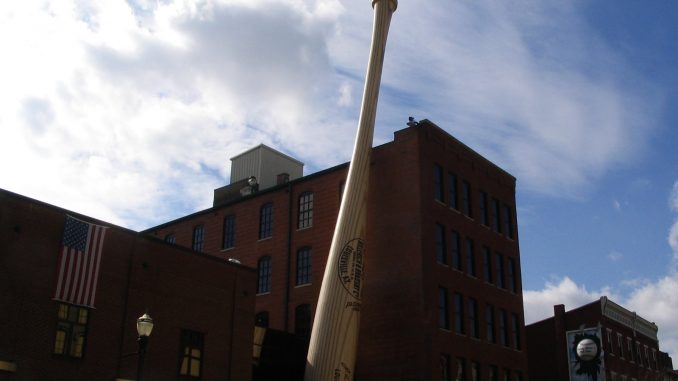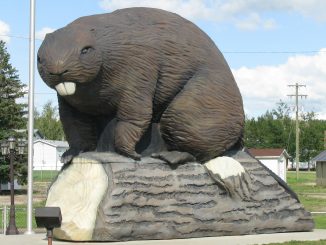
The Louisville Slugger Museum & Factory is not just a home to the world-famous baseball bat producer. It’s also a place for them to show off some of their heritage and more importantly, it’s home to The World’s Largest Bat. Outside the Louisville, Kentucky museum stands a 120-foot (km) tall carbon fiber replica bat based on the model used by Babe Ruth in the 1920s. Unlike the bat at the museum, Babe Ruth’s tiny bat was only 34 inches long.
Built in 1995, the affectionately nicknamed Big Bat has been a decades long fixture of downtown Louisville and draws visitors interested in history, baseball, sports in general, and lovers of great roadside attractions. Pilgrimages to see the giant bat and visit the museum have become almost as common as those to Cooperstown and its baseball hall of fame. Each year tens of thousands of baseball fans come from all corners of the world to see a little of the magic that helped in so many history-making home runs.
Despite local regulations, the Louisville Slugger Museum was able to circumvent local signage laws by making their giant bat part of the building’s basement bathroom plumbing ventilation system.
The museum is dedicated to the history and lore of baseball and the art of hitting. In addition to hundreds of historically important baseball bats, the museum features interactive displays, baseball memorabilia, and a short film for visitors to enjoy. The tour also details the deep history of Hillerich & Bradsby’s production of bats and golf clubs.
World’s Largest Baseball Bat Facts
- The World’s Largest Baseball Bat is 120 feet tall and reaches over the top of the five story museum outside which it lives.
- The big bat is covered in the same high quality marine paint used for military ships.
- Considering that it’s hollow, the Big Bat weighs a staggering 34 tons.
- Louisville Slugger owner Hillerich & Bradsby Co. opened the factory/museum in 1996.
- The first pro bat was created by 17-year-old Bud for Pete Browning, known as “The Louisville Slugger” in 1884.
Key Dates for the Hillerich & Bradsby Co.
- 1842: J. Michael Hillerich and his family immigrate to America.
- 1859: J. Frederic Hillerich opened a cooperage in Louisville.
- 1880: J. Frederic’s son Bud joins his father’s business.
- 1884: Bud Hillerich makes a baseball bat for Pete Browning, player for the Louisville Eclipse.
- 1894: Hillerich’s growing bat business begins using the name “Louisville Slugger.”
- 1897: The Hillerichs incorporated under the name to J.F. Hillerich & Son.
- 1905: The Hillerichs create the first autographed Louisville Slugger model, with the signature of Honus Wagner.
- 1911: Frank Bradsby joins the company.
- 1916: The company changes its name to Hillerich & Bradsby Company and begins manufacturing golf clubs.
- 1933: The Hillerich & Bradsby Company starts using the brand name PowerBilt for its golf clubs.
- 1966: The company acquires Wally Enterprises, making an entry into the hockey stick market.
- 1970: H & B contracts with a California company to produce its first aluminum bat.
- 1973: H & B moves from its Louisville facilities to Slugger Park in Jeffersonville, Indiana.
- 1978: The company purchases the California aluminum bat company with whom it had originally contracted.
- 1996: H & B moves its headquarters and bat factory back to Louisville.
Visiting The World’s Largest Baseball Bat
Visitors can see the bat outside the museum 24 hours a day for free or they can take a paid 25-minute guided factory tour.
Location: 800 W. Main St., Louisville KY
When to visit: Anytime during daylight hours
Cost: Free (to see the bat)
Height: 120 feet (36.58m)
Weight: 68,000 pounds (30,844.3kg)
Material: Carbon steel and marine paint


